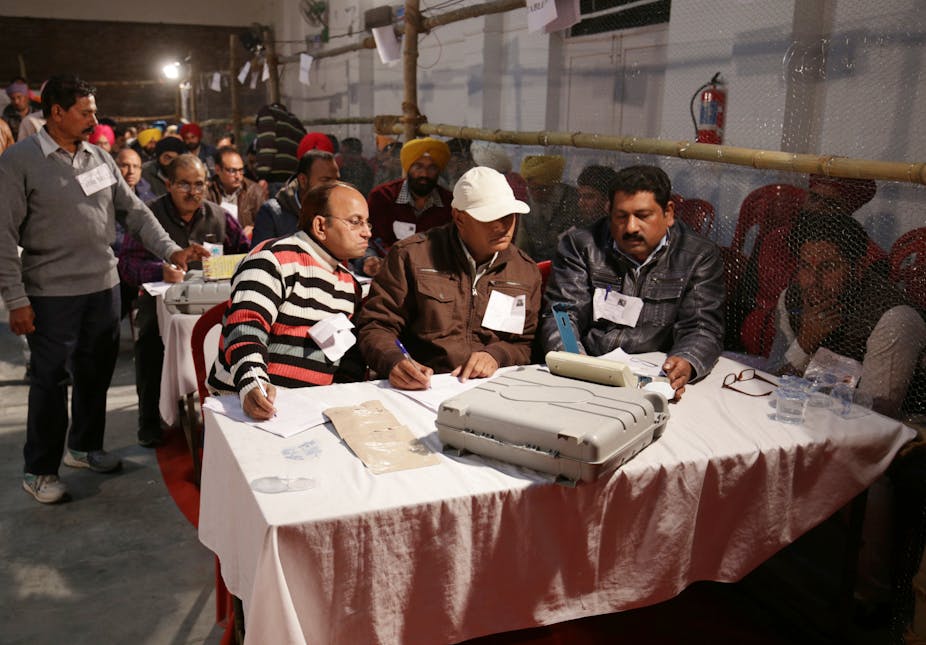The headline story from India’s recent provincial elections was the staggering victory of Prime Minister Narendra Modi’s Bharatiya Janata Party (BJP) in the state of Uttar Pradesh. But a range of politicians and observers, however, have claimed it wasn’t Modi’s charisma that won it for the BJP, but rigged voting machines.
Normally, such claims – currently unproven – would be laughed off as nothing but sour grapes. But in this case, the conspiracy theory appears to have taken root. And that it has done so illuminates some deeper concerns with the state of Indian democracy.
In Uttar Pradesh, the BJP annihilated all political opposition including the Bahujan Samajwadi Party (BSP), led by the Dalit icon Mayawati. Another surprise came in the state of Punjab, with a surprisingly poor performance by the Aam Aadmi Party (AAP), led by the current chief minister of Delhi, Arvind Kejriwal. It was widely expected to do better, having dramatically halted Modi’s momentum in the Delhi elections of February 2015.
Both Mayawati and Kejriwal, supported by various other voices, have since been arguing that the Electronic Voting Machines (EVMs) now used in all Indian elections were tampered with. Each candidate cites different “evidence” for their claims. Mayawati explained that the large crowds at her election rallies surely must have translated into more votes than she officially received; Kejriwal, meanwhile, claims that in one particular area, five of his party volunteers swear they voted for his AAP, but the registered votes show that just one did.
Both candidates are adamant that votes given to them were transferred to the BJP via voting machines, with Kejriwal claiming that as many as 20-25% of his party’s votes were stolen.
Trust eroded
The Indian state is not known for its prowess at delivering welfare services, or even efficient everyday governance, but its election commission is generally credited with the ability to hold “free and fair” elections. With the exception of several dubious elections in Kashmir, as well as stray incidents of intimidation at polling booths, the country’s democratic processes generally command widespread trust. The EVM conspiracy theory is a sign that that trust is now much shakier than it was.
To preserve its positive reputation, the election commission plans to “proactively and aggressively” prove the machines’ utter infallibility. But try as it might to pacify the complainants, this conspiracy theory is not going away any time soon.

In fact, it was given a new lease of life in early April when a machine being tested in the state of Madhya Pradesh appeared to be dispelling only BJP votes whichever button was pressed. After this public fiasco, other parties – notably the Congress – have joined the expanding chorus of EVM sceptics.
Worries that voting machines can be tampered with are far from unique to India. Indeed, several countries around the world have abandoned electronic voting altogether because of these concerns. These international examples are being repeatedly discussed as further evidence of the dubiety of EVMs.
But in a sense, whether or not the machines were rigged in the BJP’s favour isn’t the point. Conspiracy theories flourish where people feel besieged; they offer a way to make sense of the world, and can be read as critiques of the operations of power. This particularly conspiracy theory is less an uproar about rigged machines than an expression of fear at the ascendance of a dangerous Hindu majoritarianism.
The anxiety that it reflects is not with the tool – a mere machine – but with democracy itself.
Hostile majoritarianism
These latest provincial elections made it clear that the BJP is now the dominant national party of India. The future belongs to Modi and his increasingly strident Hindu nationalism, with little if any space for Muslims and other minorities. Across India, the BJP’s triumphalism has created a palpable sense of disenfranchisement among minorities and those opposed to the vision of a Hindu nation, or rashtra.
The institutionalisation of Islamophobia is already evident even at the highest levels in Uttar Pradesh, where the self-styled holy man Adityanath – notorious for his misogyny, rabble-rousing and Islamophobia – has been appointed chief minister. His counterpart in the neighbouring Himalayan state of Uttarakhand, Trivendra Singh Rawat, is a longtime member of the BJP’s militant grassroots wing, the RSS.
The first-past-the-post system might be acceptable in less authoritarian and more secular times, but now it’s enabling a belligerent and nationalistic religious majority to rule India. Mayawati won 20% of the Uttar Pradesh vote share, but it translated into a mere handful of seats, while the BJP won 40% of the vote share and 75% of the seats. It is quite possible that the BJP swept Uttar Pradesh without a single Muslim vote, even though Muslims make up almost 20% of the state’s population.
Democracy, especially in a country with India’s incredible diversity, derives credibility from its claim to speak for the people. India’s atmosphere of hostile Hindu majoritarianism is making a mockery of any such claim to representativeness.
So it’s not surprising that suspicion and alarm at the state of contemporary Indian democracy are manifesting themselves in the EVM conspiracy theory. And whatever the truth, the concerns driving the speculation demand attention.

